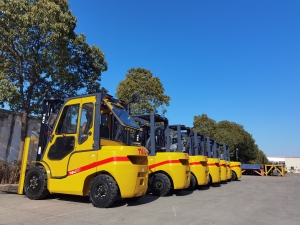Forklifts, an indispensable tool in modern industry, come in a variety of types, each designed to perform specific tasks in different environments. The diversity of forklifts is a testament to the broad spectrum of needs in various industries, from construction to warehouse management, and beyond. This article will explore several types of forklifts, their unique features, and specific applications.

Counterbalance Forklifts: The most common type of forklift, counterbalance forklifts, are designed with a counterbalance weight in the rear to offset the load lifted at the front. They have straightforward operation, with forks that can lift loads to significant heights. These forklifts are ideal for indoor warehouses and stores.
Reach Trucks: Reach trucks are designed for height. They are primarily used in warehouses where high stacking is required. Their unique design allows them to ‘reach’ into racking with the ability to extend or retract their forks, thus providing greater lift height than counterbalance forklifts.
Hand Pallet Trucks: Hand pallet trucks are manually operated, making them ideal for moving relatively light loads over short distances. They are commonly used in retail and personal warehousing due to their affordability and ease of use.
Powered Pallet Trucks: These are motorized versions of hand pallet trucks. They are equipped with a throttle for moving and lifting pallets, making them suitable for heavier loads and longer distances.
Sideloaders: Sideloaders, as the name implies, are designed to load and unload from the side. They are used in narrow aisles and for handling long, bulky loads that would be unstable on a conventional forklift.
Telehandlers: Telehandlers are essentially forklifts with a boom lift. They are commonly used in agriculture and construction for tasks that require high reach, such as lifting loads to roofs or upper floors of buildings.
Rough Terrain Forklifts: These forklifts are designed for outdoor use on uneven surfaces. They have large, robust tires and are often used in construction, agriculture, and other industries requiring off-road capabilities.
Order Pickers: Order pickers are designed for manual handling of stacked pallets. They are primarily used in warehouses, allowing operators to hand-pick items from shelves.
Container Handlers: Specifically designed for handling shipping containers, these forklifts are robust and capable of lifting heavy loads. They are primarily used in ports and shipping yards.
Stackers: Stackers are designed for stacking pallets in warehouses. They are more compact than traditional forklifts, making them ideal for operations in tight spaces.
Each of these forklift types has unique features that make them suitable for specific tasks and environments. By understanding the different types of forklifts and their applications, businesses can make informed decisions to enhance efficiency and productivity in their operations. It’s also important to note that safety is paramount when using these machines, and operators should be adequately trained to handle the specific type of forklift they are using.





